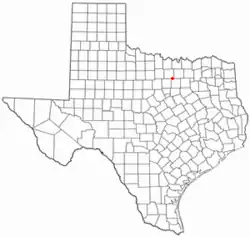Newark, Texas | |
|---|---|
 Location of Newark, Texas | |
 | |
| Coordinates: 33°0′49″N 97°29′18″W / 33.01361°N 97.48833°W | |
| Country | United States |
| State | Texas |
| Counties | Wise, Tarrant |
| Established | 1951 |
| Government | |
| • Type | The City of Newark is a type "A" General Law Municipality. The City Council consists of a Mayor and five councilmembers. The Council appoints a City Attorney, an Internal Auditor and a Municipal Judge. Council members also appoint citizens to serve on various Boards and Commissions. |
| Area | |
| • Total | 0.90 sq mi (2.32 km2) |
| • Land | 0.90 sq mi (2.32 km2) |
| • Water | 0.00 sq mi (0.00 km2) |
| Elevation | 696 ft (212 m) |
| Population (2020) | |
| • Total | 1,096 |
| • Density | 1,200/sq mi (470/km2) |
| Time zone | UTC-6 (Central (CST)) |
| • Summer (DST) | UTC-5 (CDT) |
| ZIP code | 76071 |
| Area code | 817 |
| FIPS code | 48-50772[2] |
| GNIS feature ID | 1342557[3] |
| Website | newarktexas |
Newark is a city in Tarrant and Wise counties in the U.S. state of Texas. The population was 1,096 in 2020.[4]
History
According to the Handbook of Texas, settlement began in the mid-1850s, referring to the community as Caddo Village because of numerous remnants of the Caddo Indian culture found along the banks of the West Fork of the Trinity River. After the Rock Island Railroad reached the town in 1893, officials surveyed town lots; the community was named after Newark, New Jersey, perhaps the hometown of G. K. Foster, the civil engineer who helped survey the town. Newark was a prosperous farming community until the 1920s. It regained its status as a retail market for area farmers by the end of the 1940s. In 1951 Newark incorporated.[5]
Geography
Newark is located at 33°0′49″N 97°29′18″W / 33.01361°N 97.48833°W (33.013542, –97.488418). According to the United States Census Bureau, the city has a total area of 0.89 square miles (2.3 km2), all land.[6]
Demographics
| Census | Pop. | Note | %± |
|---|---|---|---|
| 1960 | 392 | — | |
| 1970 | 407 | 3.8% | |
| 1980 | 466 | 14.5% | |
| 1990 | 651 | 39.7% | |
| 2000 | 887 | 36.3% | |
| 2010 | 1,005 | 13.3% | |
| 2020 | 1,096 | 9.1% | |
| U.S. Decennial Census[7] | |||
| Race | Number | Percentage |
|---|---|---|
| White (NH) | 697 | 63.59% |
| Black or African American (NH) | 18 | 1.64% |
| Native American or Alaska Native (NH) | 10 | 0.91% |
| Asian (NH) | 4 | 0.36% |
| Some Other Race (NH) | 4 | 0.36% |
| Mixed/Multi-Racial (NH) | 35 | 3.19% |
| Hispanic or Latino | 328 | 29.93% |
| Total | 1,096 |
As of the 2020 United States census, there were 1,096 people, 351 households, and 280 families residing in the city.
References
- ↑ "2019 U.S. Gazetteer Files". United States Census Bureau. Retrieved August 7, 2020.
- ↑ "U.S. Census website". United States Census Bureau. Retrieved January 31, 2008.
- ↑ "US Board on Geographic Names". United States Geological Survey. October 25, 2007. Retrieved January 31, 2008.
- 1 2 "Explore Census Data". data.census.gov. Retrieved May 21, 2022.
- ↑ Handbook of Texas, History of Newark
- ↑ "US Gazetteer Files 2016-Places-Texas". US Census. Retrieved January 7, 2017.
- ↑ "Census of Population and Housing". Census.gov. Retrieved June 4, 2015.
- ↑ https://www.census.gov/
- ↑ "About the Hispanic Population and its Origin". www.census.gov. Retrieved May 18, 2022.

